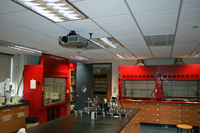 It is no secret that technology goes hand in hand with science courses and it is with this axiom in mind that Simmons Technology has partnered with faculty and staff to make dramatic improvements to the available resources in Park Science Center.
It is no secret that technology goes hand in hand with science courses and it is with this axiom in mind that Simmons Technology has partnered with faculty and staff to make dramatic improvements to the available resources in Park Science Center.
Home to all science classrooms and laboratories, as well as the School of Nursing and Health Sciences, Park Science Center is vital to both education and research at Simmons. In 2011, Technology launched a project to replace old equipment as well as add new tools throughout the building. The importance of this initiative was captured by Professor Richard Gurney, Chemistry & Physics Department Chair. When asked about past issues with technology, he said, “Faculty grew accustomed to not considering the use of IT in their laboratory sections.” Obviously, it was time for a change.
Among the steps taken to make technology available in Park Science Center, more than 80 new computers have been deployed and high-definition projectors and new projection screens were installed in 13 labs along with Blu-Ray players, document cameras, and other resources. In addition, there are two new high-definition microscopes which can connect to projectors for use during lectures and presentations, and three camera systems with digital recorders in the Nursing Simulation Labs. Lastly, Park Science Center has been part of the campus-wide upgrade to multi-function printers with scanning and faxing capabilities.
 Like many other recent Technology projects, improved security was a significant part of the project. Controllers have been installed to connect equipment to the network and allow Technology to monitor system and projector statistics and to provide more timely service as well as remote troubleshooting.
Like many other recent Technology projects, improved security was a significant part of the project. Controllers have been installed to connect equipment to the network and allow Technology to monitor system and projector statistics and to provide more timely service as well as remote troubleshooting.
While there are further improvements being planned (including additional computer and printer replacements), most of the new technology is installed and has been available during Fall semester. After many years of waiting, these upgrades should help science faculty to mesh technology with pedagogy. As Professor Gurney noted, “Now that [technology] is available, working and supported, many more faculty will incorporate the technology into their teaching in the laboratory.”